Dr Hannah Newton
Bedwetting is a normal part of early childhood. Only if it becomes habitual, or occurs in children over the age of six or seven, is it regarded as a problem.1 Even then, health professionals generally steer clear of pharmaceutical treatments, favouring instead such measures as bedwetting alarms and reward systems.2

Things were rather different in the past. When I was researching for my book, The Sick Child in Early Modern England, 1580-1720, I noticed that ‘pissing the bed’, as it was known, was classed as a ‘disease of childhood’. Midwifery manuals, paediatric texts, and collections of medical recipes, are replete with remedies for combatting this disease. Could this be a rare example of a condition becoming ‘de-medicalised’ over time?
Bedwetting was defined in the early modern period as, ‘involuntary pissing … by which Children … make water at all times’.3 Jacques Guillemeau, a French midwifery expert, outlined the causes in 1635:
Since children abound with moisture, and have their bladder but small, they must in no ways keep their water long: and therefore … some-times they bepisse themselves in their sleep.4
At this time, it was believed that life was maintained by the existence of two special substances in the body, ‘radical moisture’ and ‘innate heat’. Over the course of the lifecycle, ‘the Heat consumes by degrees the moisture’, until at last there was none left, hence death.5 Children contained the most moisture, and the elderly, the least: ageing was a drying and cooling process. Thus, bedwetting was the body’s natural response to the high level of moisture in children.
Like today, attitudes to the treatment of bedwetting varied according to the child’s age. The Suffolk medical practitioner Edward Poeton, explained,
it is best to let them alone untill they be growne bigger, and not to trouble them w[i]th many medicines: for when the childe comes to be foure or five yeares olde … it doth not so much abounde with moysture, and so by consequence not with urine.6
In other words, children would gradually stop bedwetting as their level of moisture declined. This is perhaps the origin of the idea of ‘growing out’ of a habit.
- Bed pan, England, 1501-1700
Credit: Science Museum, London. Wellcome Images
However, if bedwetting persisted into later childhood, doctors feared that it might become ‘habitual and customary’, and ‘if not cured before twenty five yeers of age,…incurable’.7 From a practical viewpoint, it is understandable why parents wished to stop this habit – centuries before the invention of plastic mattress covers and washing machines, bedwetting was more than a nuisance. It affected the whole household: children usually shared their beds with siblings, servants, and sometimes, parents. Parents often voiced their frustrations about this arrangement in their diaries and letters. Elizabeth Hervey told her husband in 1698 that their son Jack ‘did not sleep very well, which was a double trouble to me, the fear of his being ill[,] besides … being waked so often’.8
A bewildering variety of treatments were offered for bedwetting, including baths, ointments, ‘plasters’, and medicinal drinks. The aim was to dry up the moisture, and strengthen the sphincter of the bladder. The physician Lazare Rivière (1589-1655), recommended, ‘Outwardly to the Privities [genital regions], apply warm, strengthening, and drying things’, such as cypress roots, mint, sage, and pomegranate flowers.9 This method was called ‘allopathic healing’ because the medicines exhibited the opposite qualities to the cause of the disease, which in this case was moisture. Alternatively, medicines could operate through ‘sympathy’, which meant they held an affinity with the bodily organs affected by the disease, the bladder and genital parts. In 1697, the Sussex physician John Pechey suggested administering drinks made of a ‘Boar’s Bladder dried, [and] the Testicles of a Hare’.10 These treatments were also used by laypeople. An anonymous domestic recipe book held at the Wellcome Library, describes a medicine containing ‘the Stones of a boar’ or a ‘pigs bladder & a hedg-hog dryed’.11 Unfortunately, children’s own feelings about these treatments are not recorded.

Credit: Wellcome Library, London.
Bedwetting could also be treated by regulating the child’s drink intake and bowel movements. The physician from Kent, Robert Pemell, advised in 1653, ‘The child must drink but little, and let the belly of it be kept loose, for hereby they pisse lesse’.12 Keeping the belly loose meant ensuring the child was having regular bowel movements: the idea was that the excess moisture would be diverted from the bladder, and excreted in the form of faeces. Other considerations were the child’s sleep and emotions, since it was thought that all diseases were exacerbated by nightmares or emotional distress. The mother or nurse ‘must be merry and chearfull, and smile often’, and the bedchamber should not be ‘too darke’ because this ‘causes [the child] to be melancholike’.13 Pechey recommended a bedtime bath, for, ‘Children love to be clean, and will not sleep quietly till filth … [is] removed from them’.14
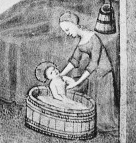
Credit: Wellcome Library, London.
Parents’ letters suggest that they sought to make bedtime a happy experience for children. In 1681, Lady Rachel Russell told her husband that their ‘girls [are] singing a-bed’.15 Elizabeth Hervey described how ‘Jack & Betty lay in bed of each side of me’, drinking hot chocolate.16
An enduring assumption in the history of childhood, is that parents in the past punished their children severely. Reactions to bedwetting challenge this myth. Guillemeau wrote, that though ‘you must … make them ashamed, of doing it’, ‘yet … you must not correct them much: for I have known some children (fearing to be beaten, if they pissed the bed) that have tyed their yard [penis] themselves, whereof followed a Gangreene’.17 Doctors warned that the fear of punishment might lead to a far more serious disease called ‘strangury’, or the inability to urinate.18 Strangury was dangerous in the young because it meant that their excess moisture would be retained within their bodies, thereby causing further diseases, and sometimes death.
In sum, early modern ideas about bedwetting were complicated and contradictory. On the one hand, ‘pissing the bed’ was a positive, natural function, which prevented other diseases by removing children’s superfluous moisture. But at the same time, it was classed as a ‘troublesome disease’, which if not cured would persist ‘till death’. Parents had to weigh up the practical and medical factors when deciding how to respond: for most, the experience of sharing a wet bed would have probably tipped the balance in favour of intervention. But this intervention was rather more kindly than we might expect, even if this era did have a penchant for the bladders of pigs and hedgehogs!
If you are interested in looking at this topic in the eighteenth century please visit the Sloane Letters blog: http://www.sloaneletters.com/bed-wetting-eighteenth-century/
 Dr Hannah Newton is a social historian of early modern England, specialising in the history of medicine, childhood, and the emotions. She is a Wellcome Trust Fellow at the University of Cambridge, undertaking a project on recovery and convalescence from illness.
Dr Hannah Newton is a social historian of early modern England, specialising in the history of medicine, childhood, and the emotions. She is a Wellcome Trust Fellow at the University of Cambridge, undertaking a project on recovery and convalescence from illness.

Her book, The Sick Child in Early Modern England, 1580-1720 (Oxford University Press, 2012), was short-listed for the Longman-History Today 2013 Book Prize, and will soon be available in paperback.
____________________
1 http://publications.nice.org.uk/nocturnal-enuresis-cg111 (accessed 19 October 2013).
2 www.patient.co.uk/health/Bedwetting.htm (accessed 19 October 2013).
3 J.S., Paidon nosemata; or childrens diseases both outward and inward (London, 1664), 140-41.
4 Jacques Guillemeau, Child-birth, or the happy delivery of women…To which is added, a treatise of the diseases of infants, and young children (London, 1635, first publ. 1612), 76.
5 J.S., Paidon nosemata, 2.
6 British Library Sloane MS 1954, fol.115r. (Edward Poeton of Petworth, ‘The Midwives Deputie’).
7 Johann Dolaus, Systema medicinale. A compleat system of physick, theorical and practical…Galenick and chymick (London, 1686), 357; Robert Pemell, De morbis puerorum, or a treatise of the diseases of children (London, 1653), 55.
8 John Hervey, Letter-Books of John Hervey, First Earl of Bristol, vol. 1, 1651-1715 (Wells, 1894), 126.
9 Rivière Lazare, The practice of physick in seventeen several books wherein is plainly set forth the nature, cause, differences, and several sorts of signs (London, 1655), 393.
10 John Pechey, A general treatise of the diseases of infants and children (London, 1697), 147.
11 Wellcome Library, London, MS8097: 0065 (English Recipe Book, 17th– 18th centuries).
12 Pemell, De morbis puerorum, 55.
13 Pechey, A general treatise, 112; Guillemeau, Child-birth, 17. This advice was given in the context of children’s sleeping arrangements, and the duties of the nurse; it is likely that it was especially applicable to conditions involving sleep, such as nightmares and bedwetting.
14 Ibid. (Pechey), 7. Thanks to Leah Astbury for providing this quotation.
15 Rachel Russell, Letters of Rachel, Lady Russell (2010, Tennessee, first publ. 1773), vol. 1, 86.
16 Hervey, Letter-Books, 115.
17 Guillemeau, Child-birth, 80.
18 Ibid., 76.
© Copyright Hannah Newton, all rights reserved.

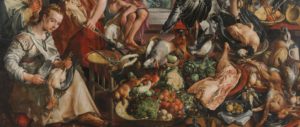
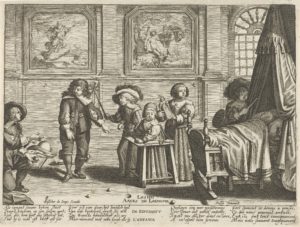
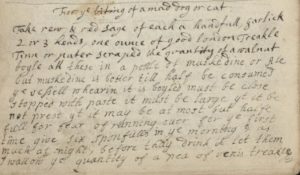
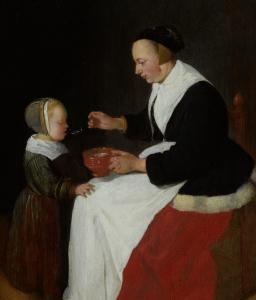
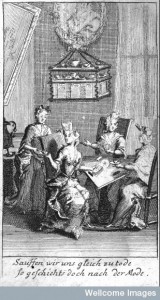
This is a great article Hannah. Did you find any evidence of gender distinctions in the discussions of bedwetting?
Thanks very much Sara. Good question! Guillemeau mentions that ‘Some thinke that wenches are more subject hereto then boyes’ (p.79)- this is interesting given that today bedwetting is twice as common in boys than in girls!
In terms of treatment, I haven’t noticed any gender distinctions – I think this was because the most important characteristic of children physiologically was their high level of moisture, a characteristic shared by both sexes. Children’s medical treatment depended above all on their age, strength, and size – doses were graduated according to these factors. At puberty, gender distinctions increased – boys became noticeably hotter, and girls’ moisture was emphasised. I think this was probably when gender became a more important variable in medical treatment. I’ll keep my eyes peeled though, for any differences!
Hannah, this is a great discussion of the various treatments and their rationale. (And certainly hints at some problems of bed-sharing!) I came across an eighteenth-century case that framed a boy’s bed-wetting in terms of negligence and self-mastery: http://www.sloaneletters.com/bed-wetting-eighteenth-century/. Some commenters mentioned other cases with physical abuse as a reaction to bed-wetting, especially among apprentices. Did you come across any in your research?
I am going to add a link to your post on this to the blog post – fits so nicely.
Thanks, so much!
Hi Lisa
Thanks for your message, and sorry about my long delay – I only just saw your message now! Those letters in your blog by young John Plowden are fascinating! So rare to see a child’s own writings.
Yep, I think there definitely was a notion that bed-wetting could proceed from a lack of self control. J.S, author of Paidon nosemata (1664), wrote that, ‘Involuntary pissing in…Children is more fa|miliar to them then those that are elder, because Children are rather governed by their appetite then will’. The cause, was once again children’s high levels of moisture: their brains were ‘drowned and drunk with moisture and humours’. As a result, children’s rational soul were partially incapacitated, and unable to properly control the lower, ‘animal soul’, the part of the soul responsible for the appetites and passions.
This explanation implies that children were not culpable for their lack of self-control – it is a natural product of their moist brains. But, at the same time, the fact that some doctors advised punishing the child, suggests that children could be ‘helped’ to overcome this natural infirmity. I think probably, in reality, responses to bed wetting would have varied according to the personality of the child.
Thanks again for your comment. 🙂